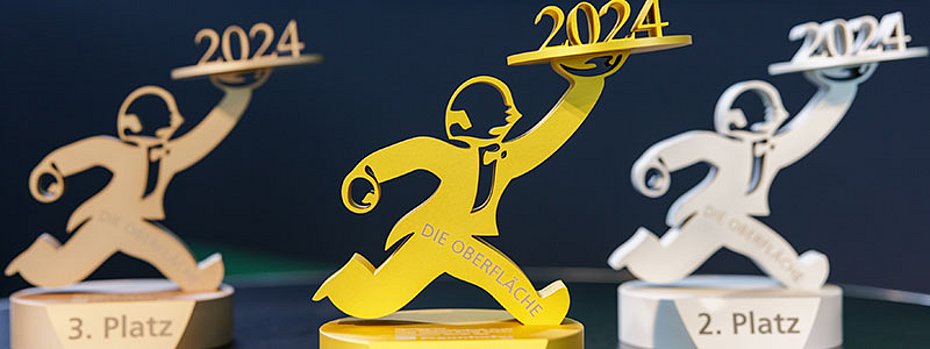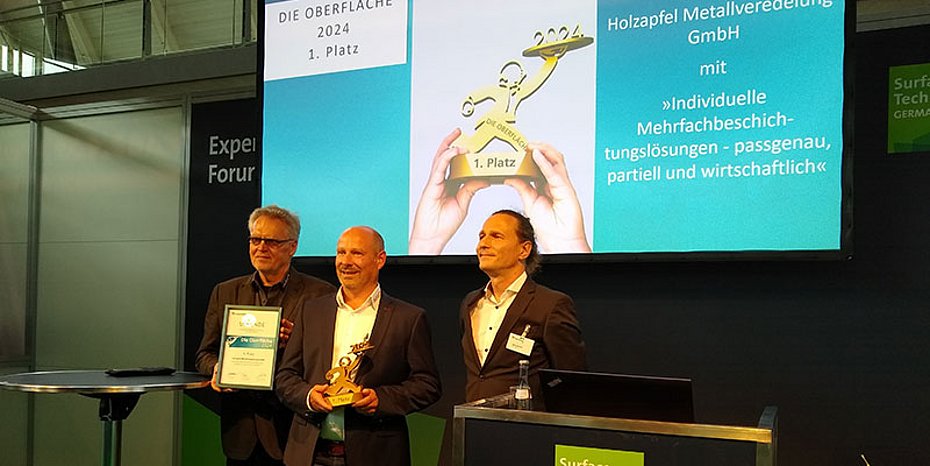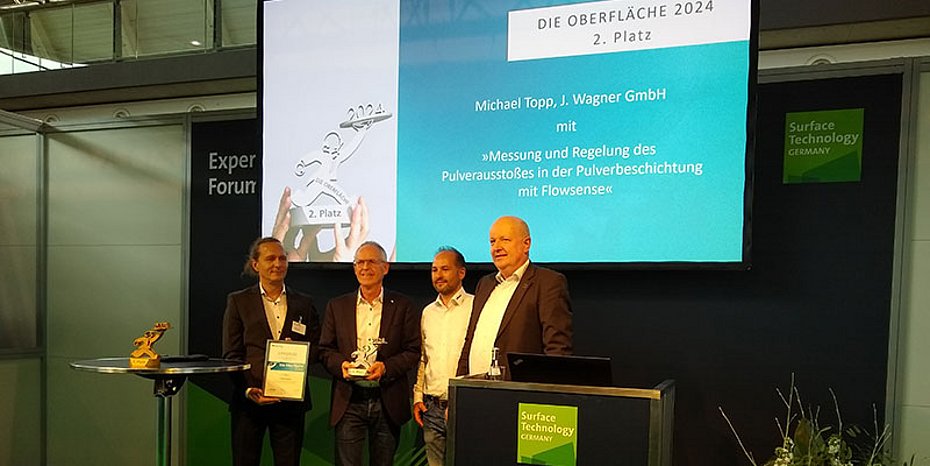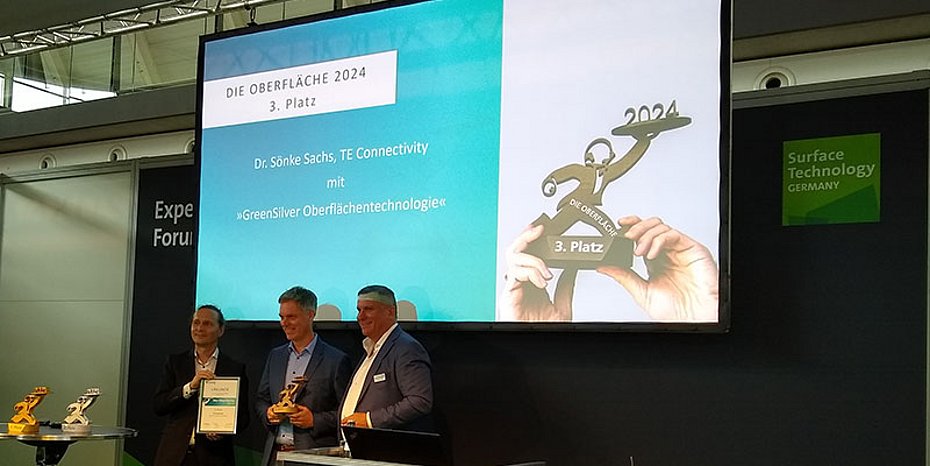"Surface technology often plays a key role in the degree of innovation and progress of numerous industries without this becoming known to the general public," says Martin Metzner, Head of the Electroplating Department at the Fraunhofer Institute for Manufacturing Engineering and Automation IPA. To recognize this ubiquitous and yet often overlooked cross-sectional and pacemaker technology, he launched the Stuttgart Surface Technology Award "The Surface" in 2012 and has been a member of the jury ever since. Until April 8, companies and individuals from all disciplines of surface technology were invited to apply for the award. Six companies were shortlisted, three of which Metzner and the other two jurors ultimately honored with the Stuttgart Surface Technology Award on June 4, 2024 at the SurfaceTechnology Germany trade forum.
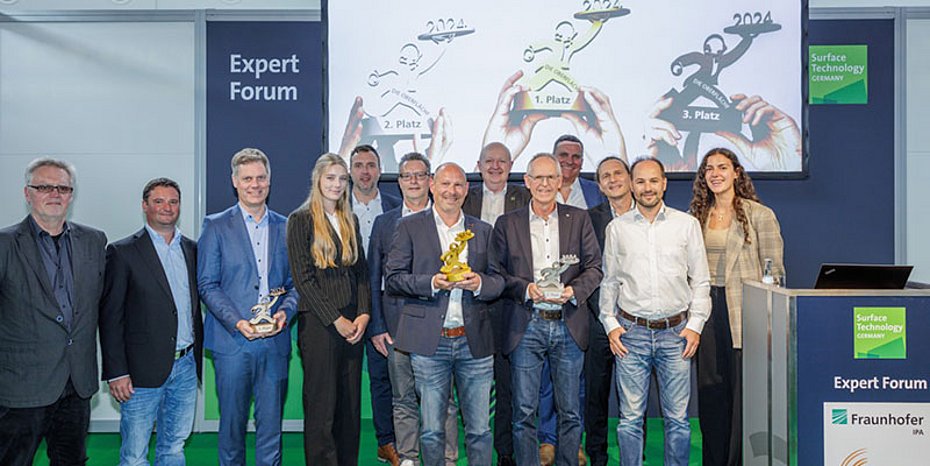
1st place: Rotating and tilting electroplating rack / Holzapfel Metallveredelung
Holzapfel Metallveredelung has developed a motorized rotating and tilting electroplating rack to meet the growing demand for multifunctional surfaces on heat sinks for power electronics. It is equipped with a programmable logic controller so that it can carry out process-specific movement sequences. Thanks to the infinitely variable swivel angle, a previously unattainable coating quality is possible on the one hand and a very high degree of variability in component alignment on the other. This maneuverability saves resources. For the first time, the rotating and tilting electroplating frame makes it possible to coat components on one side only without having to mask them first. This reduces metal consumption by 61 percent and the use of chemicals by as much as 78 percent. In addition, the energy requirement for electroplating is reduced by 385 tons ofCO2 per year.
"The innovation not only saves material, energy and emissions, but also represents a real enabler technology for the end application," praises Metzner. "What's more, the development is industrialized, which impressed the jury, particularly in view of the harsh chemical conditions in electroplating production."
2nd place: Powder quantity control system / J. Wagner
"The dosing of solids as aerosols is still challenging in terms of process technology - but in powder coating it is particularly important for high quality consistency," says juror Michael Hilt, Managing Director of the Forschungsgesellschaft für Pigmente und Lacke e.V. (Research Association for Pigments and Coatings e.V.) In addition to the necessary accuracy, there are also effects that change the powder output over time when dosing coating powders. For example, wear on the coating system causes the powder output and thus the coating thickness on the object to be painted to vary uncontrollably over time. The "Flowsense" control system from the Markdorf-based company J. Wagner can now control the powder output and keep it constant for the first time. It records pressure changes in the powder hose in various process steps and uses this to determine a reference pressure value. This control variable is proportional to the powder quantity - regardless of wear. A traffic light system visualizes the state of wear and indicates the best time to replace worn parts.
"A great deal of effort has gone into this development with a very good result that is relevant to operational practice and has successfully made the leap into practice - a real innovation in this area of coating," says Hilt.
3rd place: Environmentally friendly coating process for connectors / TE Connectivity
The increasing demands placed on connectors in vehicle electrical systems require completely new coated contact surfaces. They must be efficient and environmentally friendly to manufacture. TE Connectivity, based in Bensheim, Hesse, has developed the physical "GreenSilver" coating process, in which a combination of the two most conductive metals, copper and silver, forms the contact surface. Thanks to its fine crystalline structure and low coefficient of friction, the coating material achieves stable electrical connections, withstands temperatures of up to 180 degrees Celsius and high vibration loads. The new coating process is dry, produces no waste water and has aCO2 footprint that is up to 35 percent smaller than established electroplating processes.
"GreenSilver Contact Surface Technology enables high-performance connectors that are produced much more resource-efficiently than conventional processes," says jury member Martin Riester, Head of the Surface Technology Department at the German Engineering Federation (VDMA). "The technology presented can make a contribution to e-mobility applications, signal and power transmission and sensor technology in the automotive industry and thus also contribute to achieving the sustainability goals of this industry."
Three other companies were nominated
The company BMF from Chemnitz came fourth. It had applied to the jury with a self-learning artificial intelligence system that generates reproducible and homogeneous surface coatings and monitors the process. Fifth place was shared by Dörken Coatings from Herdecke and Chemetall from Frankfurt am Main. Dörken Coatings entered the race with a new type of coating for screws and other threaded parts that does not require toxic and extremely durable PFAS. Chemetall wanted to win the competition with a coating technology that also produces a homogeneous and all-round consistent coating on edges and inner surfaces.
The Stuttgart Surface Technology Prize "The Surface" is awarded every two years at the international trade fair Surface Technology Germany in Stuttgart. (OM-6/24)
Contact
Fraunhofer Institute for Manufacturing Engineering and Automation IPA
Nobelstr. 12
70569 Stuttgart (Germany)
Phone: +49 711 970-1800
E-mail: industrieanfragen@ipa.fraunhofer.de
www.ipa.fraunhofer.de
About the Fraunhofer Institute for Manufacturing Engineering and Automation (IPA)
The Fraunhofer IPA was founded in 1959 and employs almost 1200 people. The focus of research and development is on organizational and technological tasks in production. Methods, components and devices through to complete machines and systems are developed, tested and used as examples. The 19 specialist departments of the Fraunhofer IPA cover the entire field of production technology and work on an interdisciplinary basis with industrial companies in the automotive, mechanical and plant engineering, electronics and microsystems technology, energy, medical and biotechnology and process industries.

